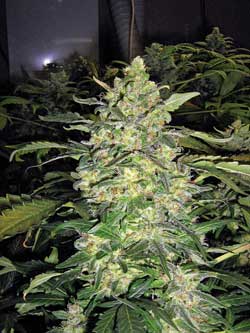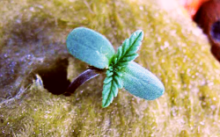You are hereHow to Take Great Pictures Under HPS Grow Lights
How to Take Great Pictures Under HPS Grow Lights
by Nebula Haze
Table of Contents
Introduction: Getting Better HPS Pictures
-
Specialized Lenses (which specifically correct HPS light)
-
Picture Editing Software (plus get a quick Photoshop tutorial)
Introduction: Getting Better HPS Pictures
HPS grow lights make it hard to take nice cannabis plant pictures. Photographing under HPS lights often make plants look yellow or orange in pictures. To make things worse, HPS grow lights that use a magnetic ballast can also add strange black bands or lines to your pictures and videos, which you don't see with your eyes.
This is what pictures often look like under an HPS grow light - everything looks yellow/orange, with little trace of the plant's natural colors.
Many growers use HPS grow lights in the flowering stage of cannabis because they are more electrically efficient and tend to get bigger yields than other HID lights. But HPS lights were not made for taking good pictures. The yellow/orange light from the HPS is noticable in the grow room, but usually looks even worse on camera. Yet growers still often want to take great pictures of their buds and plants despite the color quality of the light.
And if you're using a magnetic HPS ballast, you'll also often see black bands or lines going across your pictures, too. Although you can't see them with your eyes, these black bars even show up in videos of cannabis plants under HPS lights.
How do you get rid of these strange black bars that appear magically after the fact? How do you take natural pictures of your plants that don't seem like you're looking through a yellow windowshade? :)
How do growers take nice, beautiful clear pictures of their cannabis plants during the flowering stage with the HPS light on? What special camera settings do they use? Is there a best way to use the flash? Do people use special HPS-corrector lenses? Or do most growers just fix their pictures in Photoshop?
~Cannabis Grower
So what do you do if you want to take nice, non-yellow pictures of your plants under an HPS grow light?
There are several tricks to taking nice pictures under an HPS grow light. This tutorial will walk you through everything I've learned on my cannabis picture-taking journey.
1.) Best Option: Use Specialized Lenses Made Specifically to Correct Light from an HPS
Photographing plants under HPS lights doesn't have to be hard. There's one quick and easy fix that will pretty much solve your problems for you without any real work on your part.
Special glasses or lenses can be used to block out the black bands and yellow cast of HPS light, allowing you to see your plants in true color. If you take pictures or video through these lenses, it will allow you to take natural-color pictures without changing anything else.
This is what my garden looks like through Method 7's HPS Glasses
In addition to picture-taking, you can wear Method 7 glasses in the grow room while you inspect your plants. Not only will they help you easily see your plants and spot any potential plant problems, they protect your eyes too!
See your plants in full color while protecting your eyes from bright HPS grow lights
Get a pair of Method 7 HPS glasses on Amazon.com
Method 7 HPS glasses are a bit pricey, and there are a few other less expensive models that help block out the yellow of an HPS light (such as LumiGrow Glasses). But the Method 7's are by far the best option I know of if you want to see your plants in true color under HPS grow lights.
I know this tutorial is about photographing cannabis plants under yellow HPS lights, but for growers who are interested, Method 7 also offers a pair of glasses for LED grow lights.
2.) Take Picture in the Dark with a Flash
Taking pictures of your plants in the dark with a flash is one of the best ways to get "glamour shots" in the flowering stage, in my opinion. It really helps you see the buds and glitter as the flash bounces off all the trichomes. It also brings the colors of your plants and buds alive.
Get "Glamour Shots" of your plants by taking a pic in the dark with a flash
Taking pictures in the dark with a flash lets you see the true colors come to life
This technique shows how big your colas really are since it reflects off the trichomes on the buds
Take these pictures right before lights go on, or immediately after the lights go off. This ensures you don't interrupt the plant's dark period and put it off it's rhythm.
Polarized Sunglass Lenses will also block out the black bars from HPS lights. You can pop out a lens and use it in front of your camera.
Sometimes the best way to take a picture in the flowering stage is to avoid the light from your HPS fixture altogether. Natural lighting tends to produce the best pictures.
Here are some suggestions for timing your pics so you don't have to deal with the yellow light of an HPS.
- Right After HPS Turns On - Take pictures immediately after lights come on - when cool HPS grow lights are first turned on, they look bright white for a minute or two before they take on their regular yellow cast. If you take pictures during this window of opportunity, they will look like they were taken under natural light.
- When Moving the Plants - Generally it's a good idea to avoid moving your plants as much as possible, but sometimes it's necessary. So any time you happen to be moving the plant (for example some growers move their plants to water them, or for transplanting), take a moment to place your plant in a bright spot with a clear background, and take pics then.
If you step back from the plants, it helps incorporate more natural light and can help erase black bands that show up in pictures from a magnetic HPS ballast. The more natural light you can incorporate, the more natural your plants will look.
Use Camera Settings to help correct the lighting. For example DSLR cameras usually allow you to adjust the white balance so that it corrects for the yellow. In point-and-shoot cameras, and even many cell phones, you still usually have a "Fluorescent," "Incandescent," or "Tungsten" setting which helps give you more natural color in your pics. Sometimes these settings appear under "white balance."
Let me show you what the "Tungsten" setting achieves with my ancient Canon point-and-shoot camera that cost me $99 in 2008. You don't need an expensive camera for this to work.
Here's the original pic in "Auto" mode.
Here's the same pic after I activated the "Tungsten" setting on my camera. In my case, it was in the menu under "Light Levels," but it often appears in different places on different camera models.
Look at the difference in color when I activated the Tungsten setting!
This setting or mode is available on nearly all digital cameras if you look under the various settings, including click-and-shoot models. You'll also find these settings in iPhones and many other phone cameras. If it doesn't say "Tungsten," then look for a "Flourescent Lighting" or "Incandescent" settings, which are basically the same thing with different names.
Sometimes playing with other settings on your camera can make a huge difference. Here are some settings to play with to see if it can help you achieve better pictures.
- White Balance
- Exposure
- Shutter Speed (especially if you're seeing black lines)
7.) Use an Image Editing Software (like Photoshop) to Fix "Levels"
You can further adjust the above picture by changing the “levels” after the fact in a picture editing program like Photoshop.
Note: This technique can also be use to fix photos that appear faded, as well as basically any pictures where the whites, grays and/or blacks are showing up as the wrong color. However, the more natural your raw pictures look, the better this technique will work to bring the colors alive.
Let's start with the same yellowish picture we used in the last step (after activating the "Tungsten" setting on the camera).
Now I'm going to fix the levels in Photoshop under Images > Adjustments > Levels by using their 3 "dropper" tools on the left side of the "Levels" screen. You try to match the black dropper to black, gray to gray, and white to white. It doesn't fix every picture, but will improve many.
Play around to find out which one will work best for your picture...
Notice that the yellowish cast to the picture is greatly reduced
You can make this easier by setting up a little before you start shooting pics. If you place something in the scene that is solid black, gray or white, you can use that as a reference when correcting levels.
For example if you have a white piece of paper in the picture, you can use that as the correct "white." In the above pic the tub on the right is gray, so I know I can use at as my "gray" reference. The net pots are black in real life, so I use them as my new "black."
Basically, in the Levels screen...
- match black dropper to what should be black
- gray dropper to what should be gray
- white dropper to what should be white
If it doesn't look good, click undo and try again on other parts of the picture. A lot of pics with distorted colors can be fixed up this way!
Photoshop and other image editing software can alter the "levels" of an HPS picture and bring out more of the true colors. Here's another example of a picture before and after adjusting levels.
Jump to...
10 Tips & Tricks for Great Plant Pictures
How to Set Up an HPS Grow Light
7 Ways to Increase the Quality of Your Buds















